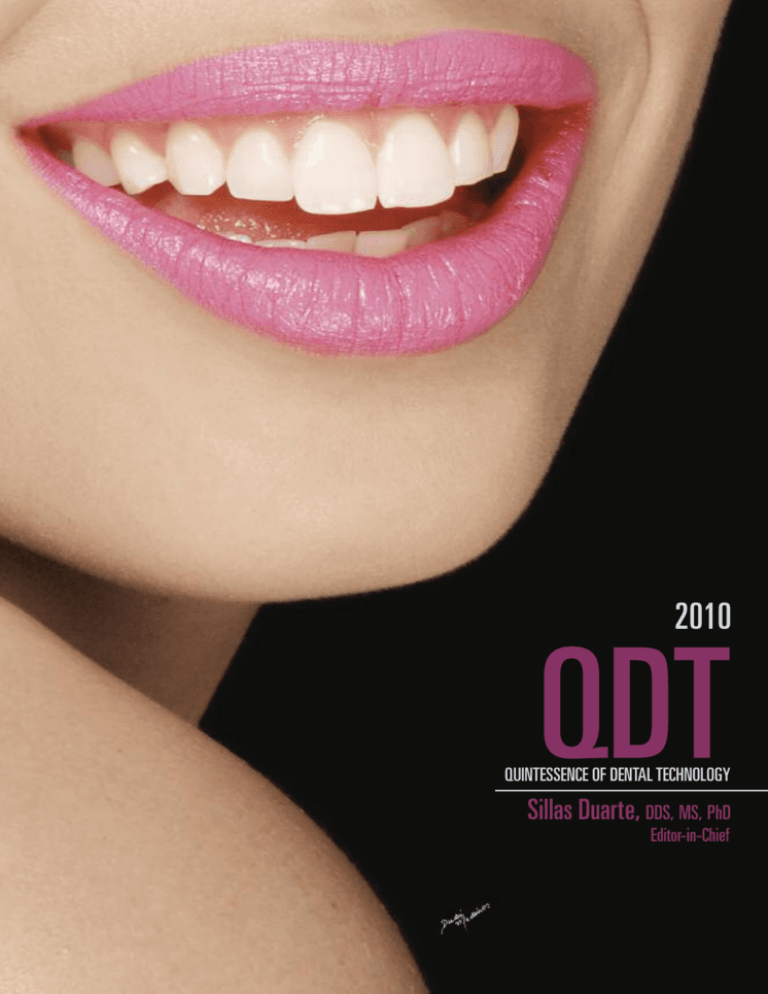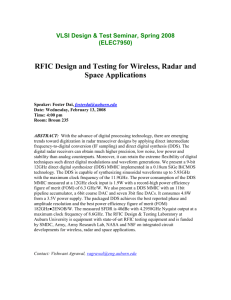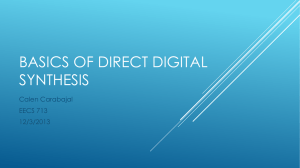
2010
QDT
QUINTESSENCE OF DENTAL TECHNOLOGY
Sillas Duarte, DDS, MS, PhD
Editor-in-Chief
2010
EDITOR-IN-CHIEF
Editorial: The Art, the Science, and the Patient
Sillas Duarte Jr, DDS, MS, PhD
Sillas Duarte Jr, DDS, MS, PhD
Associate Professor
Department of Comprehensive Care
School of Dental Medicine
Case Western Reserve University
Cleveland, Ohio
ASSOCIATE EDITOR
Jin-Ho Phark, DDS, Dr Med Dent
Assistant Professor
Department of Comprehensive Care
School of Dental Medicine
Case Western Reserve University
Cleveland, Ohio
EDITORIAL REVIEW BOARD
Pinhas Adar, CDT, MDT
Atlanta, Georgia
Naoki Aiba, CDT
Monterey, California
A Tribute: Dr John W. McLean, OBE
2
8
Gerard Chiche, DDS/David Winkler, DDS
Endosseous Implant Rehabilitation of Edentulism Using
High-Strength Ceramics and Component Prosthesis Design
11
Juan José Gutierrez Riera, DDS, MSD/Albano R. Flores, DDS/
Francisco Zarate Rivera, DDS, CDT/Thomas J. Salinas, DDS
Anterior Esthetics and Parafunction:
A Comprehensive Approach
31
Tyler Lasseigne, DDS, CDT/Hitoshi Aoshima, RDT/
Gerard Chiche, DDS
BIOMATERIALS UPDATE
Ceramic Systems: An Ultrastructural Study
42
Sillas Duarte Jr, DDS, MS, PhD/Jin-Ho Phark, DDS, Dr Med Dent/
Markus Blatz, DDS, PhD, Dr Med Dent Habil/Avishai Sadan, DMD
Amir Avishai, PhD
Cleveland, Ohio
Mike Bellerino, CDT
Metairie, Louisiana
Markus B. Blatz, DMD, PhD
Philadelphia, Pennsylvania
Karen Bruggers, DDS, MS
Cary, North Carolina
Gerard J. Chiche, DDS
Augusta, Georgia
Shiro Kamachi, DMD
Boston, Massachusetts
Minimally Invasive Reconstruction in Implant Therapy:
The Prosthetic Gingival Restoration
61
Christian Coachman, CCD, CDT/Eric Van Dooren, DDS/
Galip Gurel, DDS, MS/Marcelo A. Calamita, DDS, MSc, PhD/
Murilo Calgaro, CDT/Juvenal de Souza Neto, CDT
Appropriate Timing and Material Selection in an
Esthetic Rehabilitation
76
Michel Magne, MDT, BS/Inge Magne, CDT, BS/
Mamaly Reshad, DDS, MSc
Edward A. McLaren, DDS
Los Angeles, California
Servando Ramos, DDS
Porcelain Jacket Crowns: Back to the Future Through Bonding
89
Pascal Magne, PhD, DMD/Michel Magne, MDT, BS/Inge Magne, CDT
US Army
Avishai Sadan, DMD
Los Angeles, California
Thomas J. Salinas, DDS
Rochester, Minnesota
Tomizaku Tada, CDT
Pasadena, California
Fabiana Varjão, DDS, MS, PhD
Cleveland, Ohio
Aki Yoshida, CDT
Weston, Massachusetts
STATE OF THE ART
Esthetic Wax-up
98
Tyler P. Lasseigne, DDS, CDT
A Step-by-Step Ultraconservative Esthetic Rehabilitation
Using Lithium Disilicate Ceramic
Oswaldo Scopin de Andrade, DDS, MSc, PhD/
Gilberto A. Borges, DDS, MSc, PhD/Ariovaldo Stefani, DDS/
Fábio Fujiy, DDS, CDT/Paulo Battistella, CDT
114
Volume 33
Basics of Face Photography for Esthetic Dental Treatment
132
Snow White and Transparence, Part 2
PUBLISHER
H.W. Haase
Dudu Medeiros, BFA, MBA/Oswaldo Scopin de Andrade, DDS, MS, PhD/
Fabiana Varjão, DDS, MS, PhD
EXECUTIVE VICE-PRESIDENT
143
William G. Hartman
JOURNAL DIRECTOR
Hiro Tokutomi, RDT
Lori A. Bateman
On the Brittleness of Dental Ceramics: Why Do They Fail?
152
Opacity, Part 1: The Color Management of Porcelain Laminate
Veneers Based on the Color of Abutment Teeth
ADVERTISING SALES
163
173
Aki Yoshida, RDT/Shigemi Ishikawa-Nagai, DDS, MSD, PhD/
John D. Da Silva, DMD, MPH, ScM
All-Ceramic Restoration: A Case of Refined Surface Characterization
QDT is published once a year by
Quintessence Publishing Co, Inc,
4350 Chandler Drive, Hanover Park,
Illinois, 60133. Price per copy: $84.
189
MANUSCRIPT SUBMISSION
QDT publishes original articles covering
dental laboratory techniques and methods.
See Guidelines for Authors at
www.quintpub.com for submission information.
Francesco Mintrone, DDS/Shigeo Kataoka, CDT
Ceramic Restorations: Updates and Concepts for
Esthetic Rehabilitation
199
Paulo Kano, DDS, CDT/Luiz Narciso Baratieri, DDS, MS, PhD/
Renata Gondo, DDS, MS
Light and Shade: A Challenge to Natural Teeth
210
Naoki Hayashi, RDT
A Novel Approach for Noninvasive Pontic Site Development
Domenico Cascione, CDT, BS/Mamaly Reshad, DDS, MSc/Tae Kim, DDS
Cover photograph by Dudu Medeiros.
Quintessence Publishing Co, Inc
4350 Chandler Drive
Hanover Park, Illinois 60133
Phone: (630) 736-3600
Toll-free: (800) 621-0387
Fax: (630) 736-3633
E-mail: service@quintbook.com
Website: http://www.quintpub.com
186
Shin Nakamura, RDT
Previsualization: A Useful System for Truly Informed Consent to
Esthetic Treatment and an Aid in Conservative Dental Preparation
William G. Hartman
ADVERTISING/EDITORIAL/
SUBSCRIPTION OFFICE
Hiroki Goto, RDT
Opacity Control of Zirconia Restorations
PRODUCTION EDITOR
Patrick Penney
Renan Belli, DDS, MS/Jackeline Coutinho Guimaraes, DDS, MS, PhD/
Ulrich Lohbauer, MS, PhD, FADM/Luiz Narciso Baratieri, DDS, MS, PhD
218
Copyright © 2010 by Quintessence Publishing Co, Inc. All rights reserved. No part
of this publication may be reproduced or
transmitted in any form or by any means,
electronic or mechanical, including photocopying, recording, or any information
and retrieval system, without permission in
writing from the publisher. The publisher
assumes no responsibility for unsolicited
manuscripts. All opinions are those of the
authors. Reprints of articles published in
QDT can be obtained from the authors.
Permission to photocopy items solely for
internal or personal use and for the internal or personal use of specific clients is
granted by Quintessence Publishing Co,
Inc, for libraries and other users registered
with the Copyright Clearance Center
(CCC) Transaction Reporting Service, provided that the base fee of $5 per article
plus $.10 per page is paid directly to the
CCC, 222 Rosewood Drive, Danvers, MA
01923 (www.copyright.com). Identify this
publication by including with your payment the fee code:
0-86715-375-0/10 $5 + $.10.
Printed in Canada
ISSN 0896-6532 / ISBN 978-0-86715-375-0
Editorial
The Art,
the Science,
and the Patient
A
clear definition of art is quite complex. It is said that art is the method of deliberately arranging elements in a
way that appeals to the senses or emotions. The meaning of art is explored in the branch of philosophy known
as esthetics, which deals with new ways of seeing and perceiving the world. However, to produce art and define
a standard of esthetics, it is necessary to understand the nature, behavior, and performance of the elements that compose a particular piece of art. The systematic knowledge that is capable of predicting outcomes is science.
This issue of Quintessence of Dental Technology attempts to balance art and science with the addition of two new
sections to our regular article line-up: “State of the Art” and “Biomaterials Update.” The state-of-the-art section focuses on innovation of laboratory and clinical techniques by novel approaches. The biomaterials update section provides a scientific review that discusses new aspects, properties (physical, mechanical, optical, bonding), as well as advantages and limitations of upcoming restorative materials. Both sections are presented to inform and inspire clinicians
and technicians to a new level of exceptional service for their patients.
Ultraconservative oral rehabilitation is clearly the ultimate goal of esthetic restorations. The opportunity to preserve
and protect oral tissues by using enhanced biomaterials—with their capacity to bond any type of surface, promote
faster osseointegration, or mechanically and optically restore oral tissues, at the same time being biocompatible—
yielded a new era in dentistry. Ideally, any clinical situation can be conservatively or minimally invasively treated. The
more we can preserve dental tissues in their pristine condition, the better. But are there any limitations on how conservatively a treatment can be performed? The answer to this question truly depends on numerous factors, some of which
are beyond the clinicians’ control. The degree of salivary flow, risk of caries, periodontal involvement, age, compliance,
among other factors must be assessed before initiating a minimally invasive treatment plan. Perhaps the most important consideration is that our patients understand and want a comprehensive, but conservative, treatment plan. It is exciting that we are now able to offer a wide assortment of dental treatments ranging from conservative to invasive. It all
depends on the patient’s needs. Stress and lack of compliance are still the main causes of restorative failures, more so
than anything inherent in dental restorative materials themselves.
Fortunately, the future of restorative dentistry is bright. Upcoming technologies as well as “smart materials” will help
us to identify the benefits and limitations of a given treatment, and all boundaries will be expanded. The aforementioned technologies combined with art will permit superb esthetic oral rehabilitations. But one aspect will never
change: The patient is the one who will judge the success of the treatment. Therefore, esthetic restorations must still
be patient-driven, not materials-driven.
Sillas Duarte Jr, DDS, MS, PhD
Editor-in-Chief
sillas.duarte@case.edu
2
QDT 2010
Endosseous Implant
Rehabilitation of
Edentulism Using
High-Strength Ceramics
and Component
Prosthesis Design
Juan José Gutierrez Riera, DDS, MSD1
Albano R. Flores, DDS1
Francisco Zarate Rivera, DDS, CDT2
Thomas J. Salinas, DDS3
A
59-year-old male presented to the clinic with
maxillary and mandibular edentulism and inability to wear conventional prosthetics (Fig
1). His chief complaint was difficulty in chewing. He requested a long-term solution with functional and esthetic prostheses. His medical history was noncontributory with the exception of hypertension.
Private Practice, Monterrey, Nuevo León, Mexico.
Reproducciòn Ceramica Avanzada, Monterrey, Nuevo León,
Mexico.
3
Associate Professor, Department of Dental Specialties, Mayo
Clinic, Rochester, Minnesota, USA.
1
2
Correspondence to: Thomas J. Salinas, Mayo Clinic, Department
of Dental Specialties, 200 1st Street SW, Rochester, MN 55905, USA.
Fax: (507) 284-8082. Email: Salinas.Thomas@mayo.edu
CLINICAL PLANNING PHASE
Clinical examination revealed that both arches exhibited atrophy with mobile tissue and limited vestibular
form. Further analysis revealed compromised support
as a result of extensive residual ridge resorption of
both arches.
A panoramic radiograph revealed an edentulous atrophic maxilla with pneumatized posterior segments
and an edentulous mandible with a limited amount of
supracanal bone height in the posterior areas (Fig 2).
Study casts were mounted on a SAM 3 (SAM,
Münich, Germany) fully adjustable articulator, and the
interarch distance was determined. A diagnostic set of
maxillary and mandibular complete dentures were completed with a trial tooth arrangement (Fig 3). Based on
the patient’s edentulous situation and medical history,
several treatment plans were composed. The patient
QDT 2010
11
GUTIERREZ ET AL
27a
27b
27c
27d
27e
27f
Figs 27a to 27f (a and b) Components of maxillary and mandibular prostheses prior to assembly. (c) Hydrofluoric acid etching of gingival ceramic. (d) Phosphoric acid cleaning of zirconia surfaces. (e) Cementation of
pontics in the laboratory. (f) Securing abutment screws with torque application.
The restorations were prepared for cementation by
steam cleaning. To effectively seal the cementation
margins, the recipient cementation sites were prepared by hydrofluoric acid etching of the gingival ceramic for 30 seconds. The entire zirconia surface was
etched with phosphoric acid for cleaning. For the
mandibular prostheses, all restorations not covering
access openings were cemented extraorally (Figs 27a
to 27f). The crown restorations were prepared by
chairside treatment with CoJet (3M ESPE).19,20 Resin
cement (Unicem, 3M ESPE) was used to bond the
26
QDT 2010
restorations to the framework. The rest of the
mandibular restorations were cemented after securing
the mandibular prosthesis with abutment screws to
the manufacturer’s suggested torque. After torque application was completed, closure of the accesses was
accomplished using compacted polytetrafluoroethylene tape, and a bis-GMA zirconium silicate–filled gingiva-colored composite resin (Ceramage Gingival
Shade, Shofu, Tokyo, Japan). For maximum microleakage protection and resistance, the rest of the restorations were then bonded using resin cement.21
High-Strength Ceramics and Component Prosthesis Design
28a
28b
28c
28d
Figs 28a to 28e (a) Light-cured urethane
dimethacrylate placement jig on master cast. (b)
Transfering of abutment to mouth with placement
jig and securing with torque application. (c) Computer-aided design/computer-assisted manufacture–generated zirconia abutments ready for sequential luting. (d and e) Intaglio and occlusal
surfaces of the maxillary restoration prior to sequential luting.
Fig 29 Zirconia custom abutment with anodized titanium insert. The abutment is bonded to the prosthesis with the sequential luting technique while
the insert facilitates positioning and remains detachable.
28e
29
INTRAORAL SEQUENTIAL LUTING OF
THE MAXILLARY PROSTHESIS
For the maxillary restoration, all abutments were
transferred to the mouth and secured using an abutment placement jig after radiographic verification
(Figs 28a to 28e).
Cementation and bonding of each maxillary
crown was likewise accomplished using CoJet and
Unicem cement. Intentional crimping of the metallic
insert of each abutment facilitated retrieval of the
framework without impedance of each insert’s relative divergence angle after sequential cementation
(Fig 29).
QDT 2010
27
State of the Art
ESTHETIC WAX-UP
Tyler P. Lasseigne, DDS, CDT1
M
imicking the tooth’s natural morphology and
internal characterization is challenging. It becomes even more difficult when color is added
to the equation. An accurate esthetic wax-up not only
serves as a diagnostic tool, but it can also be used to inform and even impress the patient.
Private Practice, Baton Rouge, Louisiana; Assistant Clinical Professor, Department of Prosthodontics, LSU School of Dentistry, New
Orleans, Louisiana, USA.
1
Correspondence to: Dr Tyler P. Lasseigne, Esthetic Associates,
LLC, 16645 Highland Road, Suite J, Baton Rouge, LA 70810, USA.
Email: info@estheticassociates.com
Esthetic Wax-up
Figs 37 to 39 Final esthetic wax-up.
Final Ceramics
Figs 40 and 41 Ceramics by Hiro Tokutomi, MDT.





